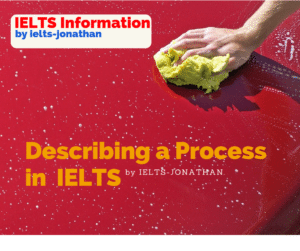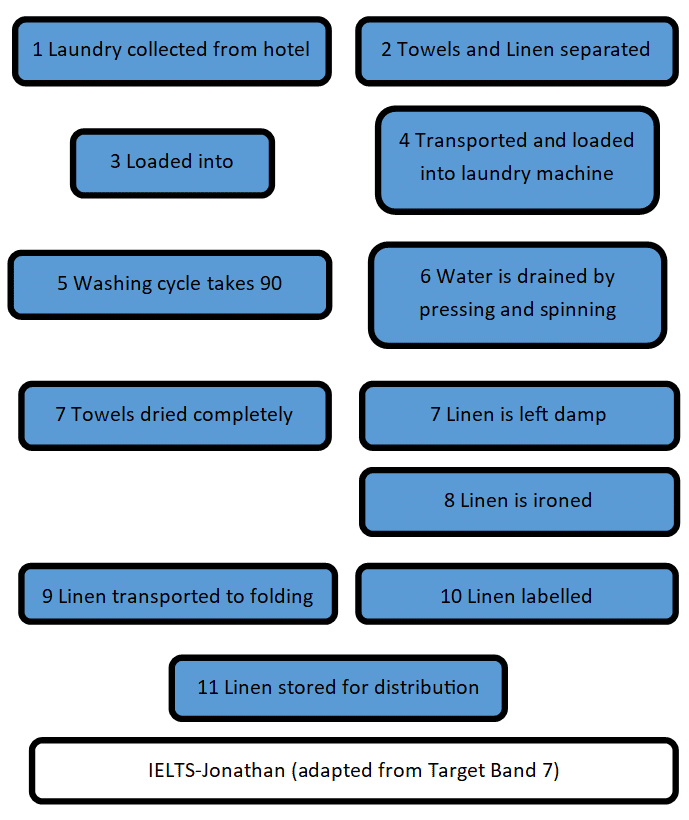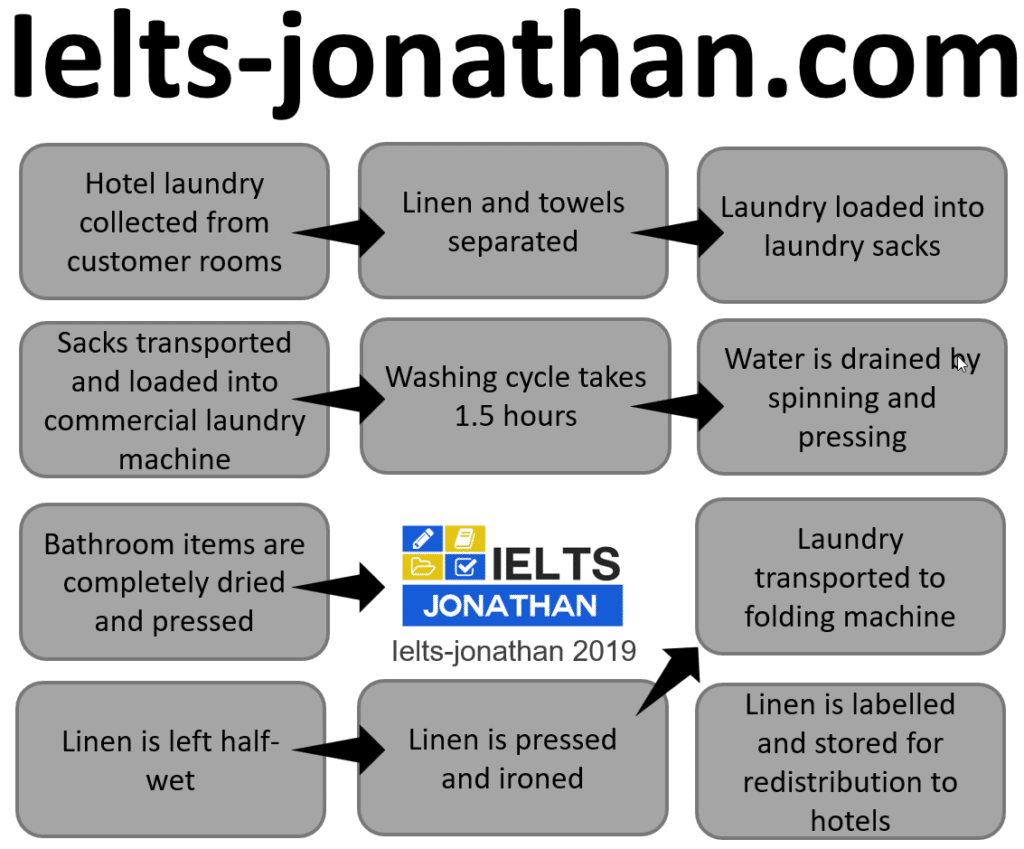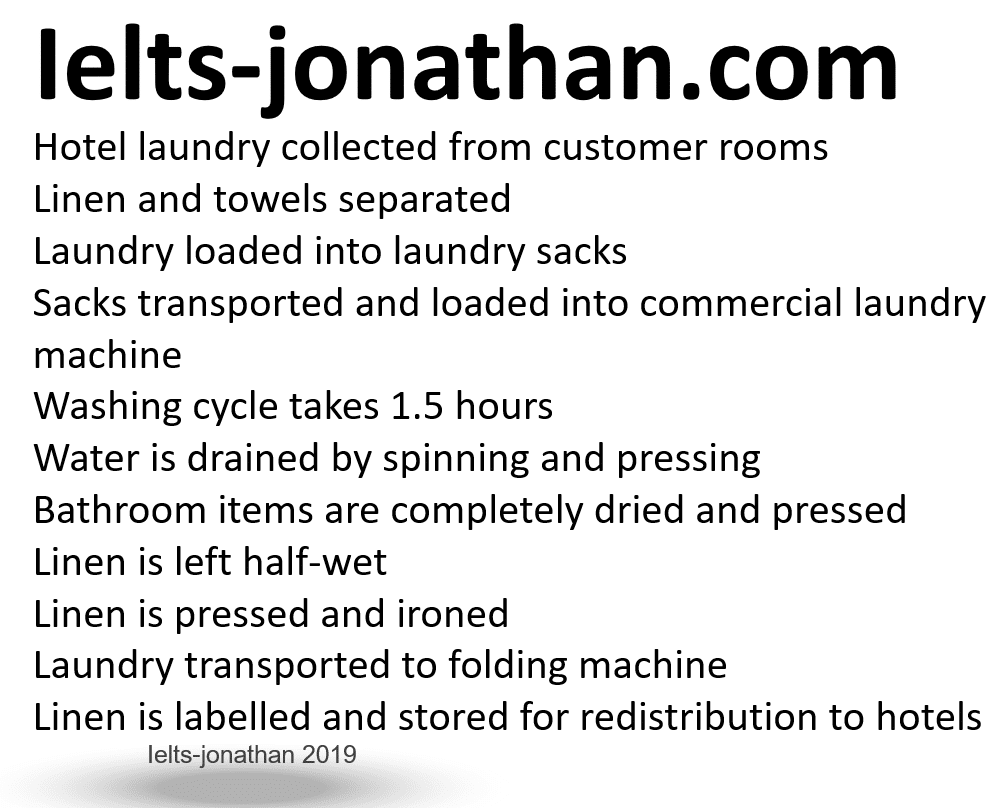Although Process Diagrams are not such a common type of IELTS question (you’re more likely to get a Graph and Chart question), you can get an IELTS Process Diagram that needs to be described.
This format of question is extremely visual and may seem easier to answer than other Task 1 formats.
Students may prepare less because these questions are appear less in the test.
This is usually a mistake.
Process Questions – The same format as any IELTS Task 1:
This is
- Introduce the diagram
- Give an overview of the main point/s (necessary for Band 6 and above)
- And provide the detail
This post will explain:
- The two types of process question
- The tried and tested method for answering any process question
- How to write the introduction
- How to write about the detail in sequence
- How to finish with a great overview
- The common mistakes IELTS students make
What is an IELTS Process Question?
These questions can be divided into two types: natural cycles and man-made processes.
Official IELTS practice questions have featured natural cycles such as the life cycle of frogs, moths or butterflies, the natural water cycle or how cows produce milk for their calves.
In contrast, practice questions have included man-made processes such as how coffee, tea or leather is made, bricks are produced or a satellite signal is transmitted and received. These typically have a start and a finish.
More good news is that the same skills and principles can be applied to both man-made and natural cycles.
Let’s consider a typical question first.
Gaining an overall understanding of the process
A process has a number of stages that are in time ordered.
So, you should start at the beginning, follow the process and describe each stage through to the final one.
In the example above, this is fairly obvious.
It begins with the collection of laundry, and ends with the storage of linen ready for the customer.
However, processes are not always as clear as this, and you may need to look more carefully to notice the beginning and ending, and two things may happen at the same time.
In this example, it’s clear that two processes might take place as one arrow becomes two, for example, there is a difference between bathroom items and linen.
It’s quite a challenge to write about something you have never seen, so it is important that you look at other sample processes to get a good understanding of how they might vary.
Don’t worry, it doesn’t need to be perfect, you only have 15 minutes and just need to notice the main features and report them in an accurate way.
TOP TIPS for understanding
- Identify where the process begins and ends
- Is it a circular process or linear with a start and a finish?
- Count the number of stages?
- Is it natural or a man-made process?
- Is anything added to the process?
- What is the function of each stage of the process?
- Is there a relationship between these stages?
- What is produced at the end? What is the product, the result?
By answering these questions, you will have already started planning your essay
Use the Passive Tense
When we describe an IELTS process, the focus is on the activities in the process rather than the person.
So to describe the activities you should be using passive grammar, rather than active grammar.
If you need to know more about the Passive voice you can read the review below, but the good news is
- The IELTS task will provide most of the verbs that you need to use
- Using the passive will avoid using the words as they appear in the text
- You only need to use the passive in the present simple tense – that’s the Present Simple Passive
Most sentences use this structure:
- Subject + Verb + Object
- A mechanical digger removes the coal from the earth.
In this active voice the digger does the verb i.e. the digger is doing the digging.
In the passive voice,
- the object (the coal) becomes the subject,
- and the subject (the digger) becomes the object.
- and the verb ‘to be’ and the past participle (or Verb 3) is also added.
Compare:
A mechanical digger removes the coal from the earth.
The coal from the earth is removed by a mechanical digger.
The second example is far more appropriate for the IELTS Process Diagram question and far more sophisticated in choice of language.
Most of the description in your IELTS process diagram will use the passive voice but some verbs cannot be passive so are written as active.
An example of this is the active verb ‘go’
‘the coffee goes through a freezing and granular separation process.’
A solution to this problem might be to use a synonymous word, as in this example.
the coffee is put through a heating and cooling process
Here’s my example. I’ve highlighted the passives in the text.
The original question
Varying your language – Use Collocations
One final tip for a higher score is variation in language.
Occasionally, it may be appropriate just to use the same language that you are given in the IELTS process diagram, but you should try to vary it.
You may be able to use nouns from the diagram as your verbs.
For example, the noun packaging near the end of the process becomes:
Finally, the bricks are packed.
Finally check for errors!
Lets go through the process again.
You can read my complete guide to Process Diagrams Here
1) Here is the question once more
You should spend about 20 minutes on this task
The flow chart below explains how hotel laundry is handled.
Using information from the flow chart describe the laundry process.
Write at least 150 words
2) Here are the task separated individually for you
3) Here is my Model Answer
http://https://www.youtube.com/watch?v=fl-dkITMp_A
You can learn more about Task 1 writing here or go straight to the my complete guide to Process Diagrams Here
I’m Jonathan
I’ve taught IELTS and University English in more than a dozen universities and schools around the world.
I’m a parent, traveller and passionate about language teaching and helping students achieve their dreams.
Whilst living in Austria or working in Asia, I run IELTS courses to help students get to where they want to be.
If you are serious about IELTS, connect with me to see how I can help you.









Was this helpful? Leave a comment :)